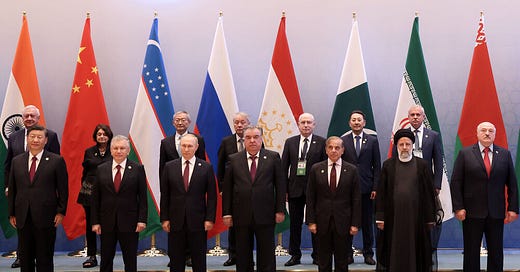Iran's Strategic Pivot to the Shanghai Cooperation Organisation: A Calculated Move?
Is the SCO worth it?
In the intricate dance of global geopolitics, nations often find themselves seeking partnerships that can offer economic relief, especially when faced with crippling sanctions. Iran's recent alignment with the Shanghai Cooperation Organisation (SCO) is a testament to this strategy, marking a significant shift in its international posture.
The SCO, primarily an economic and security pact, has been on Iran's radar since the early 2000s. Yet, it's only under the 13th administration that this aspiration has come to fruition. But what does this membership truly entail for Iran, and how might it leverage the SCO to rejuvenate its beleaguered economy?
The Dual Dynamics of the SCO
Analysing the SCO's member states, Iran finds itself juxtaposed against two distinct blocs. The first comprises nations with which Iran shares historical, cultural, and geographical ties, and has had longstanding trade relationships. These countries, familiar with Iran's economic landscape, include powerhouses like China, Russia, and India.
China, in particular, stands out. Currently, it is Iran's largest trading partner, accounting for over a quarter of Iran's total trade value. The upward trajectory of this relationship is evident; imports from China, which stood at around $5.7 billion in 2011, surged to approximately $15.7 billion a decade later. Similarly, trade ties with Russia and India have remained resilient, undeterred by international economic fluctuations or sanctions.
The second bloc within the SCO consists of nations located in Central Asia. Despite the cultural affinities and potential economic allure these countries offer, Iran has struggled to establish a robust trade relationship with them. For instance, in the past year, Iran's exports to Tajikistan, a Persian-speaking nation, amounted to a mere $170 million. In contrast, China exported goods and services worth over $1.6 billion to Tajikistan in 2021.
The Challenges Ahead
While joining the SCO opens new doors for Iran, the path is fraught with challenges.
Many SCO nations remain cautious about deepening economic ties with Iran, primarily due to American sanctions and Iran's placement on the FATF's blacklist. Economic experts and market stakeholders opine that unless these sanctions are lifted, SCO nations, especially the economically weaker ones, will be hesitant to risk enhancing trade with Iran.
Iran's primary competitors within the SCO are none other than China and Russia. Both nations have a dominant presence in Central Asia. For instance, in 2021, China and Russia collectively held 67.5% of Kazakhstan's market, 54.5% of Tajikistan's, and 44.1% of Uzbekistan's. Turkey, another regional player, has also been investing heavily in Central Asia. For Iran to carve a niche for itself in this market, it would have to contend with these established giants, a task made even more daunting given Iran's current economic dependencies on them.
The energy dynamics are intricate. While Iran is the world's fourth-largest gas producer, it also ranks fourth in gas consumption. Central Asian countries have historically relied on Russia for their energy needs. For Iran to penetrate this market, it would have to challenge Russia's dominance, a move that might be politically unpalatable.
The economic capacity of many SCO nations is limited. Apart from Kazakhstan, most are categorised as low-income countries. Their limited purchasing power means that they might not have a significant demand for consumer goods, a sector where Iran could potentially have an advantage.
Iran's SCO membership, while symbolically significant, is not a panacea for its economic woes. The real allure for the major players in the SCO, especially China, Russia, and India, is Iran's market potential during sanctions. The country's desperation for imports, especially in the face of restricted financial channels due to oil sales, makes it a lucrative target.
The Broader Implications
Beyond the immediate economic considerations, Iran's SCO membership has broader geopolitical implications. The West, particularly the United States, has long viewed the SCO with suspicion, seeing it as a counterbalance to NATO and a platform for Russia and China to expand their influence in Asia. With Iran joining the fold, the SCO's clout in regional affairs is set to increase, potentially altering the balance of power in the Middle East and Central Asia.
Furthermore, Iran's inclusion in the SCO could be seen as a subtle message to the West: Tehran has alternatives. After years of facing sanctions and diplomatic isolation, Iran is signalling that it can pivot East if its ties with the West don't improve. This move might be a strategic play to gain leverage in future negotiations, especially concerning the nuclear deal.
The Cultural and Social Dimensions
The SCO is not just an economic or political alliance; it also has cultural and social dimensions. The member states, including Iran, share historical ties, cultural exchanges, and mutual influences spanning centuries. This shared heritage can be a foundation for strengthening people-to-people ties, promoting tourism, and fostering mutual understanding. For a nation like Iran, rich in history and culture, this presents an opportunity to showcase its civilisational contributions and modern-day vibrancy.
Iran's decision to join the SCO is undoubtedly multifaceted, driven by economic, political, and strategic considerations. While challenges abound, the potential benefits – both tangible and intangible – are significant. As the global order continues to shift, with emerging powers challenging established norms, Iran's move might just be a precursor to a more profound realignment in international relations. The onus now lies on Tehran to maximise this opportunity, ensuring that its SCO membership becomes a cornerstone of its foreign policy and not just a footnote.





